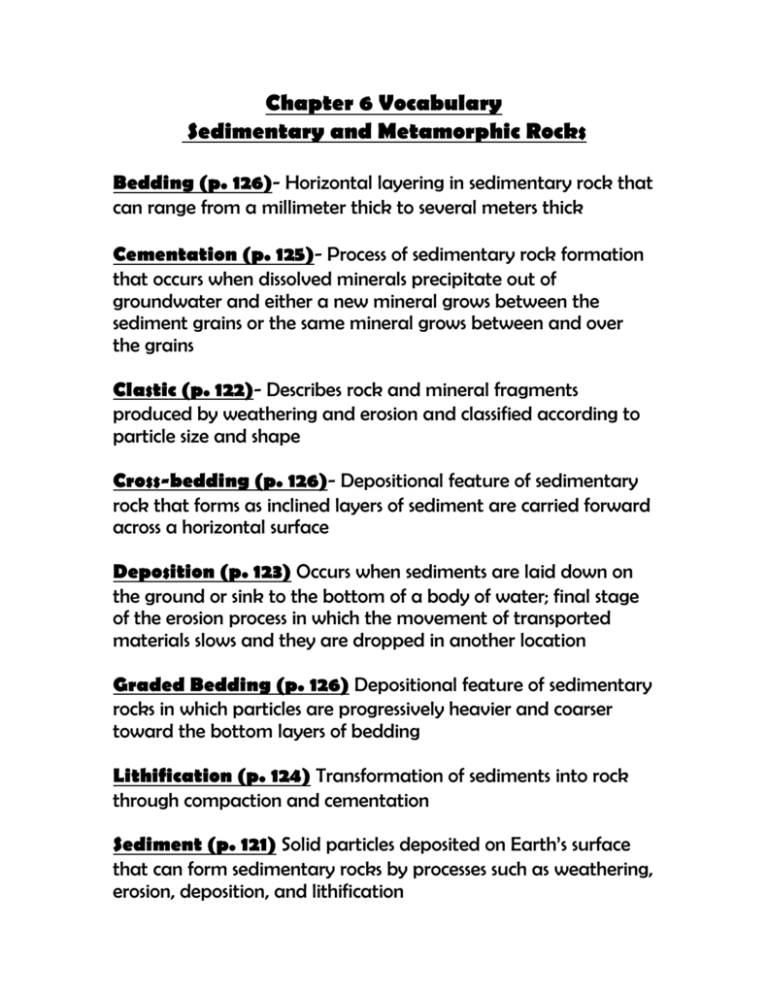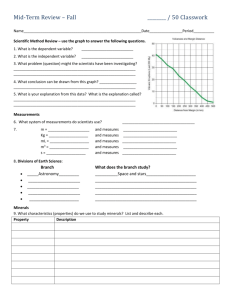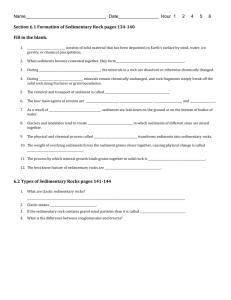Chapter 6 Vocabulary
advertisement

Chapter 6 Vocabulary Sedimentary and Metamorphic Rocks Bedding (p. 126)- Horizontal layering in sedimentary rock that can range from a millimeter thick to several meters thick Cementation (p. 125)- Process of sedimentary rock formation that occurs when dissolved minerals precipitate out of groundwater and either a new mineral grows between the sediment grains or the same mineral grows between and over the grains Clastic (p. 122)- Describes rock and mineral fragments produced by weathering and erosion and classified according to particle size and shape Cross-bedding (p. 126)- Depositional feature of sedimentary rock that forms as inclined layers of sediment are carried forward across a horizontal surface Deposition (p. 123) Occurs when sediments are laid down on the ground or sink to the bottom of a body of water; final stage of the erosion process in which the movement of transported materials slows and they are dropped in another location Graded Bedding (p. 126) Depositional feature of sedimentary rocks in which particles are progressively heavier and coarser toward the bottom layers of bedding Lithification (p. 124) Transformation of sediments into rock through compaction and cementation Sediment (p. 121) Solid particles deposited on Earth’s surface that can form sedimentary rocks by processes such as weathering, erosion, deposition, and lithification Clastic Sedimentary Rock (p. 128) Most common type of sedimentary rock, such as breccia, sandstone, and shale formed by lithification of clastic sediments Evaporite (p. 130) Chemical sedimentary rock that forms mainly in restricted ocean basins in areas with high evaporation rates Porosity (p. 129) Percentage of open spaces between grains in a rock; is highest in well sorted sediments Contact Metamorphism (p. 135) Local effect that occurs when molten rock meets solid rock Foliated (p. 136) Metamorphic rock, such as schist or gneiss, whose minerals are squeezed under high pressure and arranged in wavy layers and bands Hydrothermal Metamorphism (p. 135) Occurs when very hot water reacts with rock, altering in mineralogy and chemistry Nonfoliated (p. 136) Metamorphic rock that lacks mineral grains with long axes in one direction Porphyroblast (p. 136) Large crystals that form in solid rock by reorganization of atoms during metamorphism Regional Metamorphism (p. 134) Process that affects large areas of Earth’s crust, producing belts classified as low, medium, or high grade, depending on pressure on the rocks, temperature and depth below the surface Rock Cycle (p. 138) Continuous, dynamic set of processes by which rocks are changed into other types of rock









